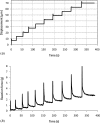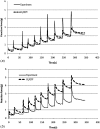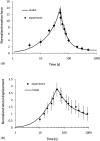A nonlinear biphasic fiber-reinforced porohyperviscoelastic model of articular cartilage incorporating fiber reorientation and dispersion
- PMID: 21950897
- PMCID: PMC3705837
- DOI: 10.1115/1.4004832
A nonlinear biphasic fiber-reinforced porohyperviscoelastic model of articular cartilage incorporating fiber reorientation and dispersion
Abstract
A nonlinear biphasic fiber-reinforced porohyperviscoelastic (BFPHVE) model of articular cartilage incorporating fiber reorientation effects during applied load was used to predict the response of ovine articular cartilage at relatively high strains (20%). The constitutive material parameters were determined using a coupled finite element-optimization algorithm that utilized stress relaxation indentation tests at relatively high strains. The proposed model incorporates the strain-hardening, tension-compression, permeability, and finite deformation nonlinearities that inherently exist in cartilage, and accounts for effects associated with fiber dispersion and reorientation and intrinsic viscoelasticity at relatively high strains. A new optimization cost function was used to overcome problems associated with large peak-to-peak differences between the predicted finite element and experimental loads that were due to the large strain levels utilized in the experiments. The optimized material parameters were found to be insensitive to the initial guesses. Using experimental data from the literature, the model was also able to predict both the lateral displacement and reaction force in unconfined compression, and the reaction force in an indentation test with a single set of material parameters. Finally, it was demonstrated that neglecting the effects of fiber reorientation and dispersion resulted in poorer agreement with experiments than when they were considered. There was an indication that the proposed BFPHVE model, which includes the intrinsic viscoelasticity of the nonfibrillar matrix (proteoglycan), might be used to model the behavior of cartilage up to relatively high strains (20%). The maximum percentage error between the indentation force predicted by the FE model using the optimized material parameters and that measured experimentally was 3%.
Figures







Similar articles
-
Determination of nonlinear fibre-reinforced biphasic poroviscoelastic constitutive parameters of articular cartilage using stress relaxation indentation testing and an optimizing finite element analysis.Comput Methods Programs Biomed. 2012 Aug;107(2):315-26. doi: 10.1016/j.cmpb.2011.07.004. Epub 2011 Jul 30. Comput Methods Programs Biomed. 2012. PMID: 21802762
-
Experimental verification of the roles of intrinsic matrix viscoelasticity and tension-compression nonlinearity in the biphasic response of cartilage.J Biomech Eng. 2003 Feb;125(1):84-93. doi: 10.1115/1.1531656. J Biomech Eng. 2003. PMID: 12661200
-
A biphasic viscohyperelastic fibril-reinforced model for articular cartilage: formulation and comparison with experimental data.J Biomech. 2007;40(8):1737-44. doi: 10.1016/j.jbiomech.2006.08.001. Epub 2006 Oct 2. J Biomech. 2007. PMID: 17014853
-
Application of finite elements to the stress analysis of articular cartilage.Med Eng Phys. 1996 Mar;18(2):89-98. doi: 10.1016/1350-4533(95)00029-1. Med Eng Phys. 1996. PMID: 8673324 Review.
-
In Vitro Mechanical Characterization and Modeling of Subcutaneous Adipose Tissue: A Comprehensive Review.J Biomech Eng. 2021 Jul 1;143(7):070803. doi: 10.1115/1.4050286. J Biomech Eng. 2021. PMID: 33625495 Review.
Cited by
-
Walking on water: revisiting the role of water in articular cartilage biomechanics in relation to tissue engineering and regenerative medicine.J R Soc Interface. 2022 Aug;19(193):20220364. doi: 10.1098/rsif.2022.0364. Epub 2022 Aug 3. J R Soc Interface. 2022. PMID: 35919975 Free PMC article. Review.
-
Subject-specific analysis of joint contact mechanics: application to the study of osteoarthritis and surgical planning.J Biomech Eng. 2013 Feb;135(2):021003. doi: 10.1115/1.4023386. J Biomech Eng. 2013. PMID: 23445048 Free PMC article. Review.
-
Linear and Nonlinear Biphasic Mechanical Properties of Goat IVDs Under Different Swelling Conditions in Confined Compression.Ann Biomed Eng. 2021 Dec;49(12):3296-3309. doi: 10.1007/s10439-021-02856-2. Epub 2021 Sep 3. Ann Biomed Eng. 2021. PMID: 34480262
-
The effect of constitutive representations and structural constituents of ligaments on knee joint mechanics.Sci Rep. 2018 Feb 2;8(1):2323. doi: 10.1038/s41598-018-20739-w. Sci Rep. 2018. PMID: 29396466 Free PMC article.
-
A review of the combination of experimental measurements and fibril-reinforced modeling for investigation of articular cartilage and chondrocyte response to loading.Comput Math Methods Med. 2013;2013:326150. doi: 10.1155/2013/326150. Epub 2013 Apr 8. Comput Math Methods Med. 2013. PMID: 23653665 Free PMC article. Review.
References
-
- Terzaghi, K. , 1951, Theoretical Soil Mechanics, John Wiley and Sons, New York.
-
- Biot, M. A. , 1941, “General Theory of Three-Dimensional Consolidation,” J. Appl. Phys., 12, pp. 155–164.10.1063/1.1712886 - DOI
-
- Biot, M. A. , 1962, “Mechanics of Deformation and Acoustic Propagation in Porous Media,” J. Appl. Phys., 33, pp. 1482–1498.10.1063/1.1728759 - DOI
-
- Kuei, S. C. , Lai, W. M. , and Mow, V. C. , 1978, “A Biphasic Rheological Model of Articular Cartilage,” Advances in Bioengineering, R. C. Eberhardt and Burstein A. H., Eds., ASME, New York, p. 17.
Publication types
MeSH terms
Grants and funding
LinkOut - more resources
Full Text Sources

